Abstract
Terrestrial ecosystems in China are threatened by land use and future climate change. Understanding the effects of these changes on vegetation and the climate-vegetation interactions is critical for vegetation preservation and mitigation. However, land-use impacts on vegetation are neglected in terrestrial ecosystems exploration, and a deep understanding of land-use impacts on vegetation dynamics is lacking. Additionally, few studies have examined the contribution of vegetation succession to changes in vegetation dynamics. To fill the above gaps in the field, the spatiotemporal distribution of terrestrial ecosystems under the current land use and climate baseline (1970–2000) was examined in this study using the Comprehensive Sequential Classification System (CSCS) model. Moreover, the spatiotemporal variations of ecosystems and their succession under future climate scenarios (the 2030s–2080s) were quantitatively projected and compared. The results demonstrated that under the current situation, vegetation without human disturbance was mainly distributed in high elevation regions and less than 10% of the national area. For future vegetation dynamics, more than 58% of tundra and alpine steppe would shrink. Semidesert would respond to climate change with an expansion of 39.49 × 104 km2, including the succession of the steppe to semidesert. Although some advancement of the temperate forest at the expense of substantial dieback of tundra and alpine steppe is expected to occur, this century would witness a considerable shrinkage of them, especially in RCP8.5, at approximately 55.06 × 104 km2. Overall, a warmer and wetter climate would be conducive to the occurrence and development of the CSCS ecosystems. These results offer new insights on the potential ecosystem response to land use and climate change over the Chinese domain, and on creating targeted policies for effective adaptation to these changes and implementation of ecosystem protection measures.
1. Introduction
Climate change and terrestrial ecosystem interactions at the local scale affect the nature, ecology, magnitude, distribution, and formation of biomes [1]. Climate variables, specifically temperature and precipitation, have been recognized as a direct determinant of large-scale ecosystem development and ranges [2,3,4,5,6,7]. Meanwhile, biogeophysical and biogeochemical processes such as lower surface albedo and increased absorbed solar radiation can produce feedback of changes in vegetation distribution and growth on the climate, exacerbating the original warming [3,6,8,9]. However, the mechanism of the response of vegetation to climate change is complex and not necessarily deterministic, which similar climates could support different vegetation ecosystems [10,11,12,13]. Steep gradients in topography and soil with similar climates, all of which influence the heterogeneity of biome patterns [14]. The evolutionary history and multi-stability of various ecosystems further contribute to this complexity [15]. Therefore, knowledge of climate change-vegetation pattern interactions is particularly important in highly heterogeneous environments such as China. The pronounced steep gradients in climate and topography of China have influenced the formation and development of biome patterns, which contribute to diversity and richness in vegetation types, which provide different ecosystem services and functions [13,16]. A forest ecosystem characterized by dense tree cover and competition for light primarily is conducive to the dynamics and structural complexity of the vegetation [17]. The grass biomass of savannas provides a range of ecosystem goods and services to people and high densities of large grazers and supplies fuel for frequent fires [17]. Therefore, understanding the terrestrial ecosystem richness and climate change-vegetation interactions of China are urgent needs for ecologists. However, a general assessment of the current patterns of the rich terrestrial ecosystems and a projection of their dynamics in response to climate change is still not sufficient.
The great diversity of terrestrial ecosystems across the China domain is affected by the synergistic effects of both climate change and anthropogenic causes, according to observational evidence [18,19]. Among climate factors, many simulated results have indicated that both rapidly rising temperatures and the precipitation events of the past decades have significantly influenced the occurrence, distribution, growth, and production potential of vegetation [2]. In the future, the mean annual temperature is projected to rise by 2–5 °C across the globe at the end of this century [2], while the mean annual precipitation would continue to increase over this century by 3–8%. Wang et al., for example, speculated that the Guangxi and Yunnan regions of southern China may face increased rainfall shortages in the future [20]. Furthermore, by 2100, China is expected to lose half of its original forests and half of its ecosystems [21]. These effects restrained the preadaptation of terrestrial ecosystems to new habitats and caused a decrease in resilience [13,22,23,24], especially for some climate-sensitive and climate-vulnerable vegetation. Among other synergistic factors, the increasing pressure of current land use also has severe consequences for the provision of ecosystem services and vegetation dynamics [25]. The practice of slash and burn, especially cutting and burning forests, also known as shifting cultivation, degrades ecosystems, causes more carbon emissions in a specific region and inhibits time to recover, which leads to land transformation [26]. In addition, overgrazing has had significant implications on land transformation in recent years, which has posed a great threat to the terrestrial ecology in China [13,27]. Therefore, although future greenhouse gas (GHG) emissions have uncertainties, exploration of the resulting climate change and current human land use in China, how they significantly affect vegetation dynamics, and where they are distributed, are essential for understanding climate-vegetation interaction and climate adaptation. However, land-use impacts on vegetation are often neglected in the exploration of terrestrial ecosystems.
Potential natural vegetation (PNV) is a direct proxy for the predicted growth stage of mature vegetation in the absence of human intervention [28,29], which is regulated only by water factors and heat and can reflect the actual relationship between climate and vegetation. Some definitions of terrestrial ecosystems are vegetation ecosystems based on the concept of PNV. As a result, precise PNV estimates will boost confidence in projections for the potential effects of future climate change and existing land use impacts on ecosystems under various climate and management scenarios [30,31]. Several prognostic models [32] have emerged and developed in recent decades to assist with these studies for estimating PNV response to climate change across various spatial scales. PNV models, such as bio-geographical models (e.g., Holdridge Life Zone (HLZ) [33]) and equilibrium vegetation models (e.g., BIOME4) [34], provide a wealth of information on the understanding of terrestrial vegetation in relation to past and future climatic variation at global and regional scales [33,35,36,37]. The HLZ model, in particular, divides the system into 38 ecological units known as Life Zones, which are defined by bio-temperature (BT), average total annual precipitation (P), and potential evapotranspiration ratio (PER). However, it was not exempt from criticism that this classification scheme does not consider the seasonality in climatic parameters and the difference in the quantitative standard between horizontal and vertical zones [38]. The BIOME4 model simulates PNV distribution by relating PNV to the geographic distribution of climate parameters, assuming both vegetation and climate are at equilibrium [34]. So, model-simulated PNV varies significantly depending on the model structure as well as the quality and characteristics of the input (or baseline) climatology data used to run the models [39,40]. The development of dynamic global vegetation models (DGVMs) now integrates vegetation dynamics and biogeochemical processes, providing a unique opportunity to investigate the transient responses of terrestrial ecosystems to rapid climate change [35,40]. Significant uncertainties, however, remain in current estimates of ecological processes at regional to global scales, coupled with the complexity of input data required, which makes it challenging to be widely applied. The Comprehensive Sequential Classification System (CSCS) model synthesizes information on bioclimatic variables, edaphic conditions, and vegetation characteristic variables in relation to water and heat conditions in a specific environment [41,42]. On a global and regional scale, the model has become a critical tool for creating strategies to mitigate the consequences of climate change on ecosystems. It has been successfully utilized to model biomes since its continuous optimization and evolution in recent decades.
If GHG emissions, climate change, and related disturbances continue at or above current rates, Fischlin et al. [39] have predicted that the resilience and adaptability of many terrestrial ecosystems and biodiversity will face an unprecedented challenge by the mid-21st century and beyond from a combination of changes in climate and associated disturbances. The negative effects of future climate change on natural ecosystems are becoming more widely recognized, as is the significant contribution of monitoring and attributing spatiotemporal variations of terrestrial ecosystems in China in response to future climate change to quantitative evaluation of climate change-vegetation growth interactions. Fortunately, Tapiador et al. have reported projections of high-resolution GCMs for future climates under the assumptions of three Representative Concentration Pathways (RCP2.6, RCP4.5, RCP6.0, and RCP8.5), which can be used as a primary source for climate change and global warming studies [43], and which have been incorporated into the Intergovernmental Panel on Climate Change IPCC Fifth Assessment Report (AR5-CMIP5) [44]. By the end of the century, the four RCPs represent radiative forcing levels of 8.5, 6, 4.5, and 2.6 W/m2, respectively [44,45]. RCPs provide a unique set of data for extensive climate modeling, global and regional analysis, and impact assessment due to their comprehensiveness in terms of sources addressed as well as geographic scale features [46].
Previous efforts to study PNV over China using this dataset, based on the CSCS model, have primarily focused on the implications of climate change on terrestrial ecosystems under a single future climate scenario or for a certain period [42] or a specific period [47]; few have tried to compare the PNV variations in China under different climate scenarios. Furthermore, a deep understanding of land use impacts on vegetation dynamics is lacking, and their succession and evolution are being ignored in the estimation of PNV across spatial and temporal scales. In addition, detailed comparisons between the CSCS model and the HLZ model on a national scale have only been implemented minimally. This situation creates a significant incentive to investigate the synergistic effects of climate change and land-use factors, as well as future intercomparison research, especially between different RCPs. To fill the gaps in this subject, it is necessary to evaluate potential changes in vegetation caused by current land use and future climate change under various RCPs.
Using the CSCS model, this study intends to quantify terrestrial vegetation over the China domain under the current baseline scenario (1970–2000) and three future climatic scenarios (the 2030s–2080s). Under the baseline scenario, PNV distribution and the effects of land use on their growth were assessed, as well as PNV variations under other climate scenarios were compared. First, a detailed comparison with the HLZ model and a vegetation map to validate the performance of the CSCS model were used. The vegetation distribution for the China domain is then simulated using a series of climatic data (average temperature, precipitation) layers under the current climate baseline (1970–2000). To examine human factor impacts on vegetation, DEM data from 1980 to 2000 were used to represent regional and temporal variability of pixels of unchanging land cover-type categories. In addition, PNV changes and compared the changes between future climatic scenarios and the existing climate baseline (1970–2000) were forecasted. The effects of succession and evolution on vegetation growth and dieback were investigated. This study provides a scientific foundation for a fair assessment and forecast of the effects of present land use on CSCS ecosystems across the China domain, as well as how they will adapt to climate change in the next decades.
2. Materials and Methods
2.1. Study Area
China is located in East Asia, on the western shore of the Pacific Ocean, with a land area of roughly 9.63 × 106 km2 (Figure 1a,b). China has a diverse climate due to its extraordinary topographical variations and complexity. From northwest to southeast, extra-arid zones, arid zones, semiarid zones, subhumid zones, humid zones, and perhumid zones exist. Different climate zones dominate different regions in China, and the diversity in climate environments has bred rich and diverse vegetation types. Frigid zones, cold temperate zones, cool temperate zones, warm temperate zones, warm zones, subtropical zones, and tropical zones dominate different regions in China [48,49]. Changes in climate indices, such as heat and humidity levels, that China may experience in the future would have a significant impact on vegetation growth in the context of global warming. Under various climate scenarios, the relationships between vegetation and climate change are inconsistent. More extreme scenarios would result in wider ecosystem responses [50], which provides potential value for our subsequent study of vegetation change in China under different climate scenarios.

Figure 1.
The major thermal level (a) and humidity level (b) in China during 1970–2000. The classification basis refers to Figure 3 and the data used in this work refers to the Section 2.2.1.
2.2. Data and Processing
2.2.1. The Baseline Scenario Data
A comparison climatic scenario is often used as a reference for the scenarios and climate change forecasts is the 1970–2000 time period. The climatic dataset is from WorldClim 2.1, which is available from World Climate Data (Table 1). This gridded dataset is provided at four spatial resolutions ranging from 30 s (~1 km2) to 10 min (~340 km2). At a 30 arc-second resolution (~1 km2), these data were utilized to construct finer estimates for month-by-month temperature and precipitation variables. By selecting the best-performing model for each location and variable, the forecast accuracy for temperature variables improves by 5–15% (0.07–0.17 °C) [51]. The data is used to drive the CSCS model, which is used to simulate PNV under the baseline scenario. The modeling findings are utilized to verify the CSCS model’s capacity to assess PNV on a national scale. In addition, using the simulated PNV, the current PNV zones in China are created under the baseline scenario.

Table 1.
Datasets used in this study.
2.2.2. The Future Scenario Data
To strengthen the study’s robustness, three RCPs were used to offset the bias caused by a single scenario as follows: one very low forcing level mitigation scenario (RCP2.6), one medium stabilization scenario (RCP4.5), and one extremely high baseline emission scenario (RCP8.5) [52]. Each future climatic scenario was separated into the following four time periods: 2020–2049 (2030s), 2040–2069 (2050s), 2060–2089 (2070s), and 2070–2099 (2080s) (Table 1). One GCM from those in the bias-corrected CMIP5 Coupled Model Intercomparison Project (CMIP5) [53] was used to run a series of climatic classifications, as follows: Meteorological Research Institute Coupled General Circulation Model version 3 (MRI–CGCM3) from the IPCC Fifth Assessment Report (IPCC–AR5) at spatial resolutions of 30 s (~1 km2). The CMIP5 dataset has been used for global changes in precipitation and in terms of seasonal changes [54]. CMIP5 projections have also been crucial for knowledge of atmospheric dynamics, present and future biases and uncertainties regarding greenhouse gas forcing, and attribution to human activities of the disruptions in precipitation cycles [55]. In addition, the MRI–CGCM3 is expected to perform well in reproducing seasonal temperature fluctuations and precipitation distribution differences between north and south [56,57,58]. All projected climate data, including monthly average temperature and monthly average precipitation, were the output data with 30 s resolution (~1 km2), which were incorporated into the vegetation model as inputs for the projected mean annual precipitation (MAP) and cumulative annual temperature above 0 °C (∑θ). All the gridded datasets are publicly available in the World Data Center for Climate due to the preponderance of decreased climate model bias by 50–70% [59].
2.2.3. The Land Use Data
The Resource and Environment Data Cloud Platform of China (RESDC) provided land use (LU) data with a 1 km2 resolution [60,61]. The grid cells of the Chinese land use (CLU) data displayed information on the vegetation ecosystem type in the area. The change in vegetation type of the pixels is expected to occur over time and through the potential impacts of humans, which could affect vegetation succession [62]. To avoid uncertainty in the results caused by particular or single-year data, the study, therefore, selected those pixels of unchanged vegetation ecosystem types from LU data during 1980, 1990, 1995, and 2000 (Table 1) because multiperiodic ensembles capture comprehensive information of both geographic and temporal variability from all participating years. These pixels were extracted to estimate the existing PNV of China more robustly under the baseline scenario. The CLU data in 1980 are reconstructed based on the Landsat-MSS remote sensing image, while the remote sensing interpretation of the data for 1990, 1995, and 2000 are performed by employing Landsat-TM/ETM [63,64]. Farmland, forest, grassland, water area (which includes water, snow, and ice) [65], residential land, and unused land are among the six groups of LU data based on land resources and their use attributes [66]. These land-use groups are combined into three categories in this study (vegetation covering the area, no vegetation area, and cultivated vegetation area) to examine how existing terrestrial vegetation ecosystems are responding to climate change. The LU dataset, the most precise product of remote sensing monitoring data of land use in China, is notably useful for concerns such as national land resource surveys, hydrology, and ecological study, with an accuracy of nearly 95% [67].
2.2.4. The SRTM-DEM Data
The SRTM-DEM data with 30 s (~1 km2) resolution are derived from WorldClim 2.1 provided by World Climate Data. The data is mainly used to extract the typical existing PNV areas (Table 1).
2.2.5. A Vegetation Map at a Scale of 1:1,000,000
In order to select a better vegetation model, a vegetation map of China at a scale of 1:1,000,000 with a 1 km resolution (Table 1) is used to validate the CSCS model and HLZ model. The vegetation map with 46 original vegetation types can reflect the actual vegetation distribution status in more detail. The data has been widely used as critical scientific information and a foundation in the domains of climate change, biodiversity, and vegetation protection and monitoring.
2.3. Methods
Figure 2 depicts the research methodologies used in this study. The following are the key processes: (1) validate the CSCS model through CSCS vs. HLZ, CSCS vs. a vegetation map, and HLZ vs. a vegetation map; (2) extract pixels of unchanged vegetation ecosystem types during 1980, 1990, 1995, and 2000 to estimate the existing PNV under the baseline climate scenario; (3) carry out the PNV dynamics analysis from 1970 through the 2080s and compare PNV variations under present and future climatic scenarios.
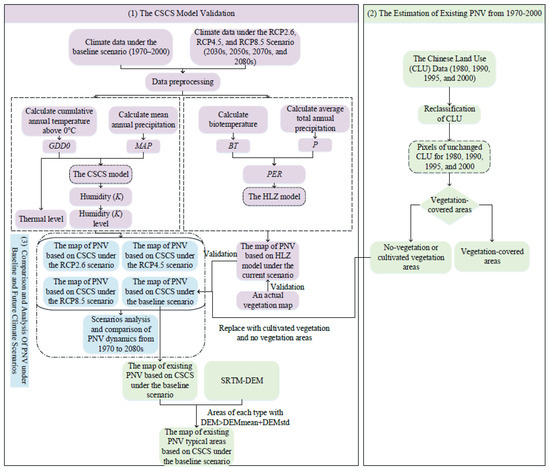
Figure 2.
Flowchart of methods used in this study. CSCS model is the Comprehensive Sequential Classification; HLZ model is the Holdridge Life Zone model; PNV is Potential Natural Vegetation.
2.3.1. The CSCS Model
The CSCS model, a complete, sequential categorization system of climate–soil–vegetation, is developed by grouping or clustering units with comparable moisture and thermal properties [41,42,68]. There are the following three levels in the system: class, subclass, and type [41,68,69]. This synthetic classification scheme attempts to account for bioclimatic conditions, edaphic conditions, and vegetation characteristics variables, and the bioclimatic conditions are supposed to be the most stable [42]. Therefore, the class level is the basic unit, and the classification of vegetation ecosystems mainly determined by bioclimatic conditions. The subclass vegetation differs in edaphic conditions, including landscape and soil, and vegetation characteristics classify the type level. Subclasses are integrated into classes based on the indexes of temperature and moisture, which capture the natural occurrence of vegetation ecosystems.
At the class level, two primary drivers of the CSCS model are annual cumulative temperature above 0 °C () (Growing Degree-Days on 0 °C base, GDD0) and humidity index (K), which are expressed by the following:
where is the mean yearly precipitation (mm); is the cumulative annual temperature above 0 °C; 0.1 is an empirical parameter. A humidity index (K) is the ratio of to Values of and K are divided into seven heat zones and six humidity levels, respectively (the index chart is available in Figure 3). The forty-two CSCS ecosystem can be theoretically produced. For explicit reflection and further comparison of the spatiotemporal distribution of PNV in China, 42 classes were regrouped into 10 super-classes based on the zonal characteristics (Figure 3) [41].
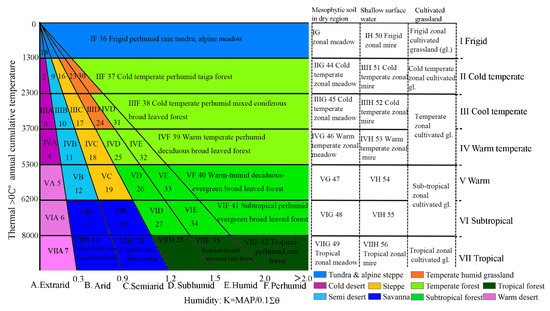
Figure 3.
Index chart in the CSCS model.
In the baseline scenario of the CSCS model, the numbers of PNV are separated into 36 classes and 10 super-classes over the China domain for the independent input variables employed as a grid format to build a PNV map (Figure 4). However, the baseline scenario did not include subtropical-extra arid subtropical desert (VIA), tropical-extrarid tropical desert (VIIA), warm-arid warm subtropical semidesert (VB), subtropical arid subtropical desert brush (VIB), tropical arid tropical desert brush (VIIB), and warm-semiarid subtropical grasses-fruticous steppe (VC).
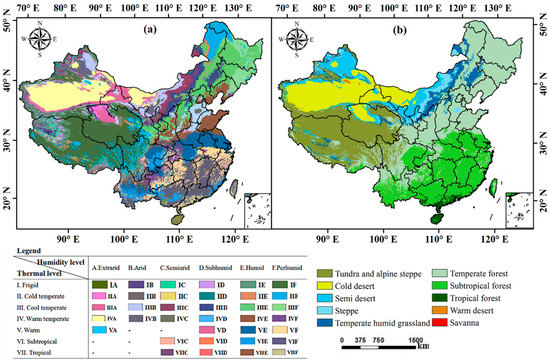
Figure 4.
Spatial distribution of PNV (a) and super-classes (b) in the baseline scenario.
2.3.2. The HLZ Model
The Holdridge Life Zone (HLZ) classification, an empirically based system, characterizes vegetation types in equilibrium with their annual climate [43]. HLZ does this by dividing the system into 38 ecological units known as Life Zones. A hexagon is drawn along the axes of biotemperature (BT), average total yearly precipitation (P), and potential evapotranspiration ratio (PER) to define each Life Zone (Figure 5) [70]. The specific calculation formula of the ecological unit is as follows:
where is the mean biological temperature (°C) the xth row and the yth column grid in the period t in the spatial raster data, with values below 0 °C substituted with 0 °C and above 30 °C substituted with 30 °C; , , , and , respectively, represent average annual biotemperature (°C), potential evapotranspiration (mm), mean total yearly precipitation (mm), and potential evapotranspiration ratio of the xth row and the yth column grid in the period t in the spatial raster data. , , and are the central climate indexes of the kth hexagon in the Life Zones; is the distance from the hexagon center in the kth Life Zone to xth row and the yth column grid.
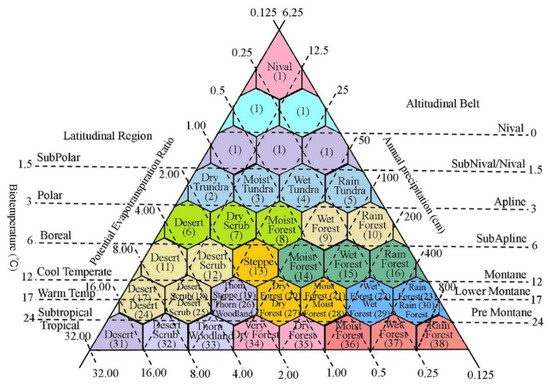
Figure 5.
The Holdridge Life Zone Model [70].
2.3.3. Vegetation Classification Schemes
To evaluate the models’ simulated distribution of vegetation under the baseline climate scenario, the following two climate classifications and actual vegetation maps are used here: the CSCS system (42 classes), the HLZ classification (38 classes), and vegetation map (46 classes). These types are described in Table A1. As a novelty compared to the previous work, the HLZ classification method was implemented, and for comparison of CSCS model output with that of the HLZ model, the original classes of these two systems and vegetation map were aggregated into the same five broad categories (Table 2).

Table 2.
Aggregation schemes of climatic classes for CSCS, HLZ, and Vegetation map. Class codes refer to Table A1 in the Appendix A.
2.3.4. Combination of Land Use/Cover (CLU) to PNV
To distinguish the non-vegetation area and the cultivated vegetation area from the natural vegetation area in the PNV map, the classification system of the CLU dataset was combined into three new classes (Table 3).

Table 3.
Combination of LU remote sensing monitoring data classification system.
2.3.5. Kappa Statistic
The Kappa statistic is used to compare and judge the accuracy and consistency of the results and is widely used to evaluate the simulated vegetation types and their spatial distributions [39]. In this study, based on GIS technology, 750 sample points were randomly selected (Figure 6). The Kappa statistic was used to evaluate the similarity and consistency between the vegetation distribution map simulated by the CSCS model, the vegetation distribution map simulated by the HLZ, and the 1:1,000,000 vegetation distribution map of China. Three potential vegetation types of distribution error matrices were generated, respectively. Then, the statistical value of the Kappa statistic of the sample vegetation type is as follows:
where denotes the total number of samples; is the number of rows and columns in the error matrix; is the individual entry for the row and column on the main diagonal of the constructed error matrix; is the row total for each category ; is the column total for each category .
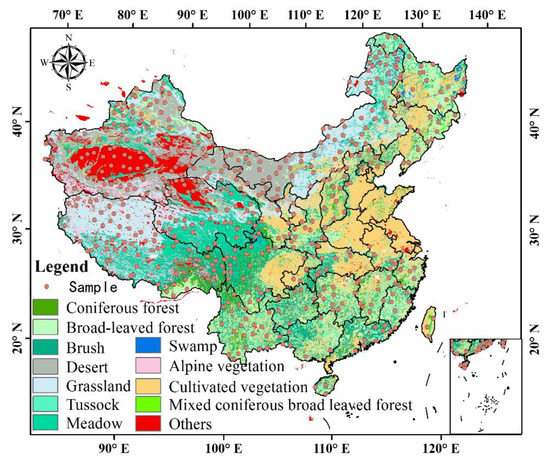
Figure 6.
Vegetation distribution map at scale a of 1:1,000,000 and CSCS model validation samples.
In general, the Kappa statistic (k) ranges from 0.0 to 1.0, with 0.0 representing totally different patterns and 1.0 indicating complete agreement. The generic evaluation thresholds of the statistic are shown in Table 4.

Table 4.
The evaluation thresholds of Kappa static.
2.3.6. PNV under Current Baseline Scenario
It is important to note, in the real environment, that the PNV of China was altered to a great extent by the influence of human activities; with that in mind, a map of the current PNV map based on the CSCS model was produced. Our goal in choosing a strategy for gathering credible data for the present PNV map of China was to create a system that supplied numerous samples of each land cover class from many years in order to reflect spatial and temporal heterogeneity [71]. To create a contemporary PNV map of China, pixels of the unchanging land cover of the first level from reclassification LU data for the years 1980, 1990, 1995, and 2000 as a data source were used. Specifically, spatial overlay analysis between the unchanged pixels of cultivated vegetation or no vegetation in reclassification LU data and PNV map was carried out in the ArcGIS, obtaining a distribution map including vegetation area, no vegetation area, and PNV area.
2.3.7. Typical Areas of PNV under Current Baseline Scenario
Although the scope of human activities is everywhere, there are still some areas where the PNV is consistent with the PNV under current baseline scenario, such as some coasts and river banks in the high latitude areas of the Arctic and Antarctic and high altitude areas [72]. In order to eliminate human interference factors to determine the typical areas current PNV in China, the altitude element and then were selected as the typical distribution areas of existing PNV the regions of DEM > DEMmean + DEMstd from each PNV type [73]. This work aims to provide a scientific basis for field investigation and selection of biological characteristics of different PNV types [74].
3. Results
3.1. Performance of the CSCS Model
To evaluate the performance of the CSCS model, a comparison with classification results (Figure 7a) from 1970 to 2000 using the HLZ model (Figure 7b) generates 36 and 30 PNV classes, respectively, with a kappa index of 0.75; the CSCS PNV and the vegetation distribution map at a scale of 1:1,000,000 generates good-to-very good agreement (K value of 0.6), while the HLZ PNV and the map of actual vegetation generate fair-to-good agreement (K value of 0.4). The previous relevant study [75] also calculated the K value (0.74) for CSCS PNV vs. HLZ PNV. The good-to-very good agreement for CSCS PNV vs. the vegetation distribution map at a scale of 1:1,000,000 (overall K value of 0.6) is similar to that of the HLZ PNV vs. the map of actual vegetation (overall Kappa statistic of 0.4). It is notable that the CSCS model has a higher K index than the HLZ model. In other relevant studies, Zheng et al. [76] and Yates et al. [70] also calculated similar results. Therefore, we think the CSCS model performs better in simulating the PNV in China. Figure 8 shows the aggregated graphs, which provide a visual account of the commonalities (Figure 8a) and differences (Figure 8b,c) between different terrestrial ecosystems derived from the CSCS model and the HLZ model. The results show a consensus of 743.96 × 104 km2 between the outputs of these two models directly over the maps, covering nearly 77% of the total national area. However, there are significant mismatches between these two models in, for instance, the cases of the North China Plain, Northeast plain, Greater Hinggan Mountains, Inner Mongolia Plateau, Altai Mountains, Zhungeer Basin, Kunlun Mountains, Qilian Mountains, Tibetan plateau, Hengduan Mountains, Yunnan-Guizhou Plateau, Arbitrary Mountains, and Taiwan Mountains. This is more apparent in the relatively high-altitude regions, with inconsistent areas of more than 216.41 × 104 km2, amounting to 37% of the total land area of China, where a slight difference in the annual mean of temperature and precipitation variables may decide the classes to which they belong.

Figure 7.
Comparisons of the vegetation maps of China based on CSCS model (a) and HLZ model (b).
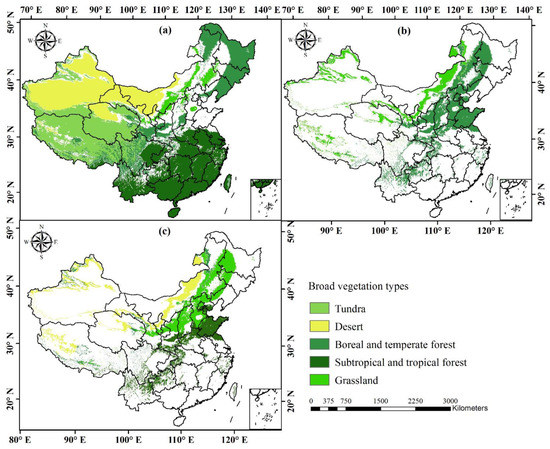
Figure 8.
Comparisons of the vegetation maps of China based on CSCS model with HLZ in the baseline scenario. The areas of consistent class (a), the inconsistent regions for classes based on CSCS model (b), and the inconsistent pixels for each class based on HLZ model (c).
3.2. Spatial Distribution of PNV in the Baseline Scenario
In the application of such CLU dataset, for extraction of those pixels of unchanged land cover-type categories during 1980, 1990, 1995, and 2000 to capture more both geographic and temporal variability, the map is driven by CLU data is composed of the following three zones: PNV areas, cultivated vegetation areas, and no vegetation areas (Figure 9). Spatial patterns of the current PNV areas, 36 PNV classes from 10 super-classes performed by the CSCS model, are highly variable over the China domain in the baseline scenario (Figure 10). In general, the 36 PNV types from 10 super-classes were estimated to occur in the northwest, west, and south of China, with 664.24 × 104 km2, covering nearly 69% of the total national area. Specifically, frigid perhumid rain tundra and alpine meadow (IF) are the most distributed vegetation, followed by cool temperate-sub humid meadow steppe (IIIE) and warm temperate-extrarid warm temperate zonal desert (IVA) (Table A2). Among them, IF is estimated to dominate in the cold and wet areas of the Qinghai-Tibet Plateau, the Tianshan Mountains, and the Altai Mountains; the IIIE shows prominent distribution characteristics of the south side of Xiaoxing’anling, Daxing’anling, and Nanshan of Qinghai; the occurrence and development regions of IVA are the Tarim Basin, the Inner Mongolia Plateau, and the Zhungeer Basin. In addition, the cultivated vegetation zones, including artificially planted arable land, farmland, and dry land, appear in the North China Plain, the Sichuan Basin, the Middle and Lower Yangtze Plain, the Northeast Plain, the Junggar Basin, the Tarim Basin, and the Yinshan Mountains, which are simulated to cover 103.71 × 104 km2, accounting for 11% of the total national area. Moreover, no vegetation zones, at 55.58 × 104 km2, accounting for 6% of the total area of China, consist of water areas and residential land, which are scattered in the Junggar Basin, Tianshan Mountains, Kunlun Mountains, the middle and lower reaches of the Yangtze River, the Northeast Plain, and the North China Plain.

Figure 9.
The 3D color pie charts for percentage of consistent class. Inconsistent class based on the CSCS model and HLZ model (a), percentage of inconsistent regions for each class based on CSCS model (b), and percentage of the inconsistent pixels for each class based on HLZ model (c) in the baseline scenario.
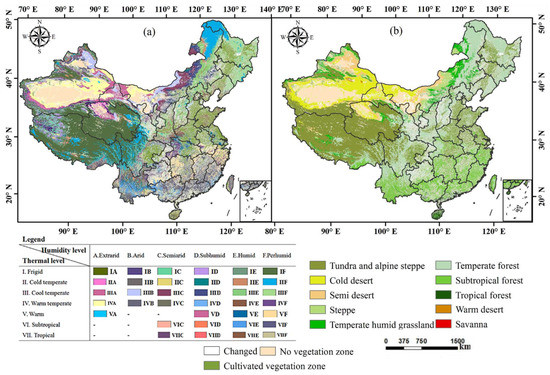
Figure 10.
Spatial distribution of PNV (a) and PNV super-classes (b) in the baseline scenario.
As to PNV types, the lowest DEMmean values (14.03 m) are observed in the tropical-subhumid tropical xerophytic forest (VIID) (Figure 10), followed by the warm-extrarid subtropical desert (VA) (99.12 m), the warm–subhumid deciduous broad-leaved forest (VD) (156.24 m), and the tropical-humid seasonal rain forest (VIIF) (157.55 m) in the baseline scenario (Table A2 and Figure 11). The results suggest that above-vegetation from the forest or warm desert grassland with higher thermal grade occurs in tropical/warm areas, for instance, the Turpan Basin. Meanwhile, VIID, with the smallest DEMrange of only 33 m (DEMmax-DEMmin), is also the vegetation with the most concentrated vertical distribution. However, frigid-subhumid moist tundra, alpine meadow steppe (ID) is the vegetation with the highest DEMmean reaching 4764.47 m, followed by frigid-humid tundra, alpine meadow (IE) (4748.41 m), frigid-semiarid dry tundra, alpine steppe (IC) (4701.97 m), and frigid perhumid rain tundra, alpine meadow (IF) (4684.98 m). Moreover, this vegetation from the tundra and alpine steppe with the lowest heat level is projected into frigid and relatively humid regions, such as the Qinghai-Tibet Plateau, the Kunlun Tianshan, and the Altai Mountains. Moreover, the highest DEMrange values are estimated for IF, the most extensive distribution vegetation, reaching 4934 m.
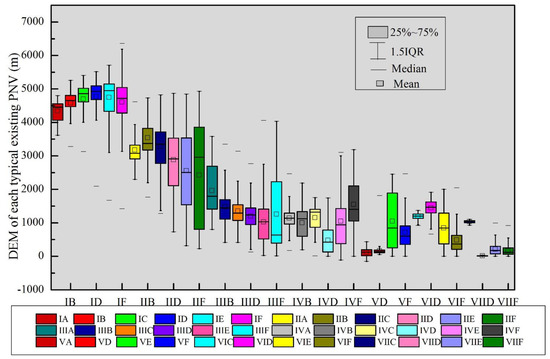
Figure 11.
Statistical variability in DEM values for different PNV types. Refer to Table A2 for PNV classification code. IQR represents the interquartile range.
3.3. Spatial Distribution of PNV in Typical Areas in the Baseline Scenario
An additional and valuable application of DEM data is the simulation of the spatial distribution of special PNV areas in the baseline scenario by selecting as the typical areas of PNV the pixels of DEM > DEMmean + DEMstd from each PNV type (Figure 12 and Figure 13). As to total areas of PNV, the typical areas of PNV are projected to be only 96.10 × 104 km2, accounting for 10% of current PNV regions or 11% of national land areas. These results are consistent with those of Feng et al. [67]. From the spatial distribution perspective, these vegetations occur in the Tianshan Mountains, the Kunlun Mountains, the Altai Mountains, the Himalaya Mountains, and the Hengduan Mountains. There are apparent environmental characteristics of high altitude, complex topography, and sparse population in these distributed regions, resulting in the absence of human intervention. This result is encouraging because it provides the scientific basis for field investigation and selection of biological characteristics of different PNV types. However, according to our results, population expansion and broad-scale agricultural activities are two dominant factors that affect the occurrence and development of terrestrial vegetation.
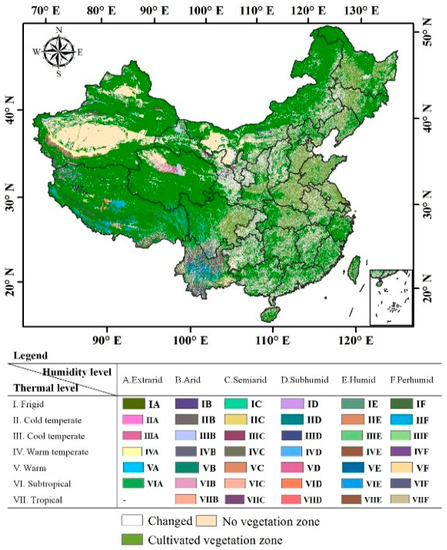
Figure 12.
Spatial distribution of PNV in typical areas in the baseline scenario.
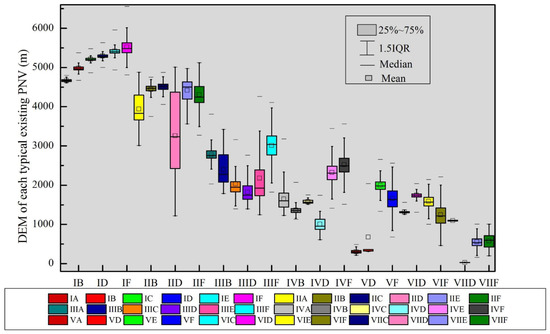
Figure 13.
Statistical variability in DEM values for different PNV types in typical areas. Refer to Table A2 for PNV classification code. IQR represents the interquartile range.
Although the relationship between the DEMmean range of PNV in typical areas and their thermal level is observed to be overall similar to that of existing PNV, both the DEMrange and DEMstd of each PNV in typical areas decrease significantly relative to existing PNV, especially for frigid–humid tundra and alpine meadow (Table A2 and Figure 13).
3.4. Changes of PNV Super-Classes under Future Climate Scenarios
Figure 14 and Figure 15 and Table 5 indicate the temporal changes in regional distribution, areal extents, and fractions of PNV super-classes under future climatic scenarios. Forests, the most widely dispersed vegetation, are projected to account for around 48% of the whole nation’s land area. Temperate forests are the most widely dispersed vegetation, accounting for 247.93 × 104 km2, or about 47% of the total country area. Although there are growing tendencies in the area of temperate forest from the 2030s to the 2080s under the three scenarios, the vegetation is expected to decline the most compared to the current climate baseline condition among the three forest types, according to the findings (Figure 14). With 55.06 and 15.5 × 104 km2, respectively, the RCP4.5 and RCP2.6 scenarios would have the greatest and smallest losses in the temperate forest areas. Tropical forests, on the other hand, are expected to spread consistently over the next century, increasing most of the three forest types. The RCP8.5 scenario has the largest area growth of 46.30 × 104 km2, whereas the RCP2.6 scenario has the smallest increase of 18.80 × 104 km2. In the RCP2.6, RCP4.5, and RCP8.5, subtropical forests would have fluctuating increases (rise at first, reduce later, and increase eventually), steady increases, and fluctuating declines (increase and then decrease). However, in the three scenarios, the vegetation’s areal extents show small increasing tendencies relative to the current baseline, with the RCP2.6 scenario showing the most apparent changes of 14.34 × 104 km2.
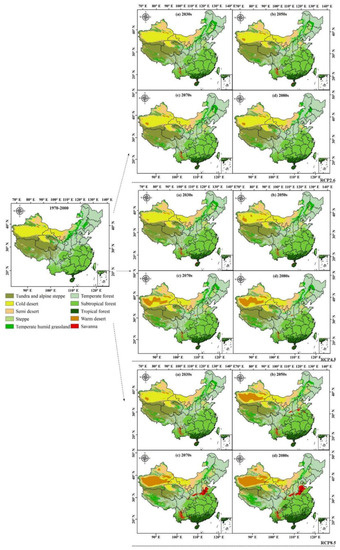
Figure 14.
Spatial distribution of PNV super-class under the baseline (left) and future climate scenarios (right).
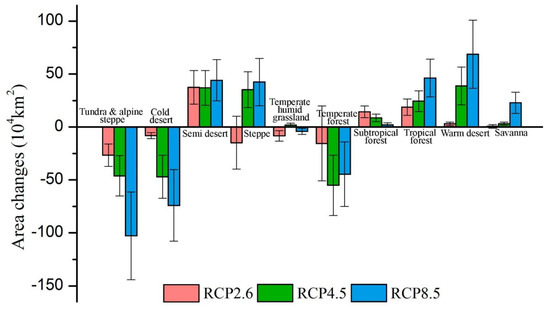
Figure 15.
Areas changes of PNV super-classes in 2080s relative to 1970–2000 under RCP2.6, RCP4.5, and RCP8.5 scenarios.

Table 5.
The areas of each PNV type in China in the future climate scenario.
Grasslands are the second most widely dispersed vegetation, accounting for about 29% of the total national area. Although tundra and alpine steppe are expected to be the most widely dispersed grasslands, they will suffer and face significant dieback as a result of the warmer and wetter environment over this century. In the RCP2.6, RCP4.5, and RCP8.5 scenarios, tundra and alpine steppe areas would decrease by 26.62, 46.16, and 102.83 × 104 km2, respectively. Similarly, the steppe area would also decrease by 14.85 × 104 km2 under the RCP2.6, while the shrinkage of 8.4 × 104 km2 and 4.14 × 104 km2 in temperate humid grassland would occur in the RCP2.6 and RCP8.5, respectively. By contrast, savanna would benefit from future climate change, and the distributed extents are expected to expand continuously across all three scenarios. The most dramatic change in savanna would occur in the RCP8.5 by 22.84 × 104 km2, and the least expansion is predicted to happen in RCP2.6 by 0.61 × 104 km2.
Deserts, which are the least widely dispersed flora, are projected to cover just 26% of the total nation’s area. Under all three scenarios, the cold desert with the broadest distribution would consistently shrink the most over the next century among the three desert types. At the end of this century, the RCP8.5 is anticipated to lose the most land in cold desert areas, by 74.12 × 104 km2, while the RCP2.6 will lose the least land, by 8.14 × 104 km2. By contrast, although a fluctuating trend (increase at first and decrease later) in the warm desert is observed from the 2030s to the 2080s under the RCP2.6 scenario, a significant expansion would occur relative to the baseline scenario situation across all the three scenarios. The area of warm desert would increase by 3.02, 38.82, and 68.72 × 104 km2 in the RCP2.6, RCP4.5, and RCP8.5, respectively. Similarly, semidesert would present fluctuating trends from the 2030s to 2080s in the RCP4.5 and RCP8.5, which would decrease at first and increase later in the RCP4.5 and expand and then shrink in the RCP8.5, respectively. However, there is an apparent increasing variation in the areal extent of semidesert compared with the baseline climate scenario state under the three climate scenarios, by 37.46, 36.92, and 44.09 × 104 km2, respectively.
3.5. Succession among PNV Super-Classes over Time
The significant successions among different PNV super-class types during this century are projected across all three RCP scenarios (Figure 16). Additionally, a Sankey diagram is used to visualize the succession patterns (Figure 17).
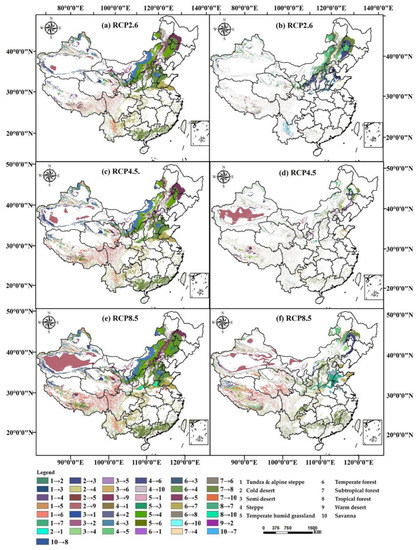
Figure 16.
Spatial distributions of successions among PNV super-classes from 1970–2000 to 2050s (left) and from the 2050s to 2080s (right) under RCP2.6 (a,b), RCP4.5 (c,d), and RCP8.5 (e,f).
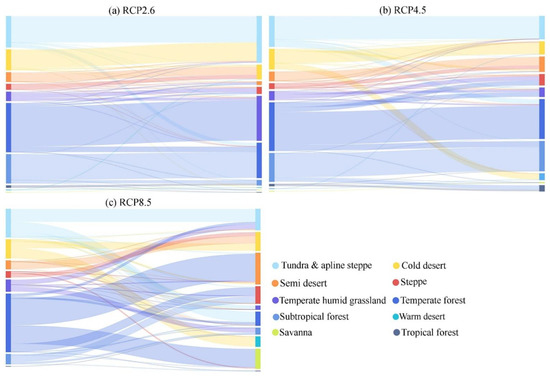
Figure 17.
Sankey diagram for successions among PNV super-classes from 1970–2000 to 2080s under RCP2.6 (a), RCP4.5 (b), and RCP8.5 (c) climate scenarios, respectively.
From the future climate scenarios perspective, future climate change significantly impacts vegetation under the RCP8.5 scenario, where PNV super-classes exhibit the most apparent succession, at approximately 534.85 × 104 km2, followed by RCP2.6 (333.80 × 104 km2) and RCP4.5 (357.28 × 104 km2). As a result, in the future context of climate change, more harsh climates produced by climate change will result in larger ecological responses.
As to vegetation types, grasslands are projected to experience the most succession across all the three scenarios, which would evolve into deserts and grasslands at approximately 52.35 × 104 km2 and 33.59 × 104 km2 during T0 to T4, accounting for 61% and 39% of their losses, respectively. Among all the conversions from four grasslands to three forests, it is expected that the area of tundra and alpine steppe converted into the temperate forest in the future would be the most. The most significant succession from tundra and alpine steppe to temperate forest is projected in the RCP8.5 scenario during T0–T4 with 68.71 × 104 km2, at approximately 66% of losses for the tundra and alpine steppe. The succession would mainly occur in the western and southern parts of the Tibetan Plateau, the Qilian Mountains, the Hengduan Mountains, the Himalayas, the Tianshan Mountains, and the Altai Mountains. Concurrently, 28.93 × 104 km2 of evolution from the steppe into semidesert, the most dramatic change pattern among all types of evolution from grasslands to deserts, is also projected for RCP8.5 for 97% of grasslands losses. The evolution would happen in the Inner Mongolia Plateau, the Taihang Mountains, Qilian Mountains, and Tianshan Mountains.
Forests, the dominant vegetation type, are observed to undergo the second-largest succession across all three scenarios. During T0–T4, there are 50.96 × 104 km2 and 1.00 × 104 km2 of forests degraded into grasslands and deserts, accounting for 98% and 2% of their losses, respectively. The sharpest degeneration from forests to grasslands and deserts would occur in RCP8.5 in T0-T2 periods. Based on this result, more than 49.42 × 104 km2 and 1.88 × 104 km2 of temperate forest located adjacent to the North China Plain and Northeast China Plain are predicted to change to steppe and semidesert, respectively.
There are minor losses in deserts among all the three vegetation types that are expected to convert into grassland of 1.33 × 104 km2 and forests of only 0.02 × 104 km2 from T0 to T4. In the Northeast Plain, 2.74 × 104 km2 of semidesert would be converted into steppe during T2–T4 under RCP8.5, which may be most succession from deserts into grasslands.
4. Discussion
4.1. Discussion of the Methodology
The CSCS model and theory is a statistical model based on bioclimate, which was used in this study to quantitatively simulate the vegetation maps under baseline scenarios as well as predict their dynamics and succession trends in different periods (the 2030s–2080s) under RCPs scenarios. Our results exhibit that the CSCS model can not only successfully assess the spatial distribution of grassland, forest, and desert at the national scale but also performs better in simulating the PNV in China than the HLZ model. As well as known, the CSCS was established by climate–soil–vegetation [65]. The humidity index, determined by mean yearly precipitation (MAP) and cumulative temperature, is the main input in the CSCS. However, the precipitation variable does not consider other supply factors, especially underground water and melt water effects, which may cause the underestimation of the water variable and reduce the accuracy of the humidity index. In addition, this system does not take into account the terrain effects, which are likely to have negative impacts on the accuracy in regions with complicated underlying surfaces. Therefore, the terrestrial vegetation was simulated for a 30-year period on a national scale. To minimize the biases of PNV in China, 42 classes were regrouped into 10 super-classes based on the zonal characteristics. Moreover, land use and altitude factors were taken into account in this study. The CSCS enables a feasible approach to assessing the spatiotemporal distribution of terrestrial vegetation under climate conditions globally and regionally. Thus, the CSCS performs promising applications in the field of past and future change, especially for regions or periods with limited data.
4.2. GHG Adaptation Measures
Incrementing GHG concentrations yields increasingly more profound changes, with much of the world shifting towards different climates from those in the present. However, ecosystem-climate feedbacks and interactions are often highly non-linear and non-additive. Although our study has not focused in detail on the impacts of specific vegetation afforestation and vegetation progression on future climate change, some general concepts are discussed below.
The two main sources of uncertainty of climate impacts on vegetation are projections of future climate and their resulting impacts on vegetation. Since changes in climate and vegetation ecosystems depend on complex interactions between the atmosphere, biosphere, and precipitation cycle, there is a need for effective and comprehensive climate impact assessments. A more integrated representation of vegetation in climate models should therefore allow more robust quantification to assess the impacts of climate change in the past, current, and future on vegetation. Based on the CSCS model, we focus on predicting quantitatively the spatiotemporal dynamics of the vegetation ecosystem in China using RCPs datasets. In particular, the ecological responses (e.g., succession from tundra and alpine steppe to temperate forest) of the western and southern parts of the Tibetan Plateau and the Qilian Mountains would be significant in RCP8.5 from 1970–2000 to the 2050s, since the local vegetation development would be primarily influenced by temperature and precipitation changes due to GHG emissions.
Future climate change impacts on vegetation changes in China will depend on the balance between changes in productivity and rates of decomposition and GHG emissions, both of which depend on climatic, land use, and management factors. Changing land management practices within vegetation land uses could also alter the climate, which in turn affects vegetation. In addition, vegetation productivity is likely to be reduced by the precipitation redistribution process in China. Changes in future water management practices will alter the effectiveness of vegetation mitigation strategies, such as ecological vulnerability and water supply for irrigation. Adaptation in the ecological protection sector could potentially provide additional benefits such as vegetation development for reduced flood risk and increased drought resilience in China.
4.3. Uncertainties
In this study, uncertainties exist in the simulation of PNV. The accuracy of the baseline and future scenario datasets may appear to be less certain. The predicted results of PNV depend on the accuracy of the dataset used to drive the CSCS model. Tapiador et al. have suggested that GCMs from those in the bias-corrected CMIP5 are still too limited to extract definite estimates of the regional and world climates, even for present climate conditions [43]. Although the dataset used from MRI–CGCM3 with a decreased climate model bias by 50–70% is expected to perform well in reproducing seasonal temperature fluctuations and precipitation distribution differences in China, the error source of this dataset has been reported to possibly come from the homogenization and interpolation methods. Some regions where the observation data are relatively few or the observation sites are scattered may result in some errors in the classification accuracy of the CSCS model.
5. Conclusions
Using the CSCS model, terrestrial vegetation was quantitatively estimated over the China domain under the present baseline scenario (1970–2000) and three future climatic scenarios (2030s–2080s). We focused on evaluating the CSCS model’s performance and PNV distribution under the present baseline scenario as well as examining PNV fluctuations as a function of climate change.
Present-day land use and future climate change imply heavy pressure on China’s ecosystems and biodiversity. Although their future trajectories may be uncertain, the CSCS model has become an indispensable tool for developing strategies to mitigate the consequences of global climate change on ecosystems, which has a wide range of potential applications in understanding climate-vegetation interactions under different future climate scenarios.
From the current situation, the regions of typical current PNV occupy less than 10% of the total national area caused by human land use and cropland expansion. Moreover, these ecosystems only dominate in high altitudes, complex topography, and sparse populations, where they are not prone to human intervention under the current baseline scenario. A closer view of these ecosystems raises that the higher altitude may be conducive to the occurrence and development of some vegetation ecosystems to a certain extent, especially for low thermal vegetation.
By the end of the 21st century, a variety of climatic impacts on vegetation across the China domain are expected, with consequences varying greatly across various terrestrial ecosystems. Harsher climate induced by climate change might result in larger ecosystem responses, according to the simulated results based on the CSCS model in the context of future climate change. As a consequence of a warming climate, despite some advancement of temperate forest at the expense of substantial dieback of tundra and alpine steppe from 1970–2000 to the 2080s, all emission scenarios agree that this century would witness a considerable shrinkage of temperate forest.
In general, a warmer and wetter climate would be conducive to the occurrence and development of terrestrial vegetation to a certain extent. However, these changes would restrain some ecosystems, which would suffer irreversible degradation in the future, particularly in the mid-/high elevations. Ultimately, although future greenhouse gas (GHG) emissions have uncertainties, our potential CSCS-based analyses of current and future terrestrial ecosystem processes in China are paramount to enhancing our understanding of human intervention impact on vegetation and suggesting possible future scenarios for terrestrial vegetation ecosystems’ dynamic and diverse biosphere-future climate change interactions under different future climate scenarios. Adaptation in the ecological protection sector could potentially provide additional benefits to vegetation development, such as reduced flood risk and increased drought resilience in China.
Author Contributions
S.L.: Methodology, Software, Writing original draft, Visualization. J.Z.: Conceptualization, funding acquisition, Writing review and editing, Visualization, Supervision. D.C.: Software, Methodology, Writing review and editing, Validation. S.Z.: Software, Methodology, Writing review and editing, Validation. Y.B.: Software, Methodology, Writing review and editing, Validation. S.Y.: Resources, Methodology, Writing review and editing. M.H.: Writing review and editing. All authors have read and agreed to the published version of the manuscript.
Funding
This work was supported by the “Taishan Scholar” Project of Shandong Province (No. TSXZ201712), the Open Fund of Key Laboratory of Urban Land Resources Monitoring and Simulation, Ministry of Natural Resources (No. KF-2021-06-081), Natural Science Foundation of Shandong (Nos. 2018GNC110025, No. ZR2020QE281, ZR2020QF067), and Natural Science Foundation of China (No. 41871253).
Institutional Review Board Statement
Not applicable.
Informed Consent Statement
Not applicable.
Data Availability Statement
Not applicable.
Acknowledgments
The authors appreciate the anonymous reviewers and the editors for their valuable comments for significantly improving this manuscript.
Conflicts of Interest
The authors declare that they have no known competing financial interests or personal relationships that could have appeared to influence the work reported in this paper.
Appendix A

Table A1.
The PNV classes for the CSCS model and the HLZ model.
Table A1.
The PNV classes for the CSCS model and the HLZ model.
| Classification System | Class Name and Code | |||
|---|---|---|---|---|
| CSCS | IA | Frigid-extrarid frigid desert, alpine desert | ID | Frigid subhumid moist tundra, alpine meadow steppe |
| IIA | Cold temperate-extrarid montane desert | IID | Cold temperate subhumid montane meadow steppe | |
| IIIA | Cool temperate-extra arid temperate zonal desert | IIID | Cool temperate-subhumid meadow steppe | |
| IVA | Warm temperate-extra arid warm temperate zonal desert | IVD | Warm temperate sub humid forest steppe | |
| VA | Warm-extra arid subtropical desert | VD | Warm-subhumid deciduous broad leaved forest | |
| VIA | Subtropical-extra arid subtropical desert | VID | Subtropical-subhumid sclerophyllous forest | |
| VIIA | Tropical-extrarid tropical desert | VIID | Tropical-subhumid tropical xerophytic forest | |
| IB | Frigid-arid frigid zonal semidesert, alpine semidesert | IE | Frigid-humid tundra, alpine meadow | |
| IIB | Cold temperate-arid montane semidesert | IIE | Cold temperate-humid montane meadow | |
| IIIB | Cool temperate-arid temperate zonal semidesert | IIIE | Cool temperate-humid forest steppe, deciduous broad leaved forest | |
| IVB | Warm temperate-arid warm temperate zonal semidesert | IVE | Warm temperate-humid deciduous broad leaved forest | |
| VB | Warm-arid warm subtropical semidesert | VE | Warm-humid evergreen- broad leaved forest | |
| IB | Frigid-arid frigid zonal semidesert, alpine semidesert | VIE | Subtropical-humid evergreen broad leaved forest | |
| IIB | Cold temperate-arid montane semidesert | VIIE | Tropical-humid seasonal rain forest | |
| IC | Frigid-semiarid dry tundra, alpine steppe | IF | Frigid-perhumid rain tundra, alpine meadow | |
| IIC | Cold temperate semiarid montane steppe | IIF | Cold temperate perhumid taiga forest | |
| IIIC | Cool temperate-semi arid temperate typical steppe | IIIF | Cold temperate perhumid mixed coniferous broad leaved forest | |
| IVC | Warm temperate-semiarid warm temperate typical steppe | IVF | Warm temperate perhumid deciduous broad-leaved forest | |
| VC | Warm-semiarid subtropical grasses-fruticous steppe | VF | Warm-humid deciduous-evergreen broad-leaved forest | |
| VIC | Subtropical-semiarid subtropical brush steppe | VIF | Subtropical perhumid evergreen broad-leaved forest | |
| VIIC | Tropical-semiarid savanna | VIIF | Tropical-humid rain forest | |
| HLZ | 1 | Polar desert | 20 | Warm temperate dry forest |
| 2 | Subpolar dry tundra | 21 | Warm temperate moist forest | |
| 3 | Subpolar moist tundra | 22 | Warm temperate wet forest | |
| 4 | Subpolar wet tundra | 23 | Warm temperate rain forest | |
| 5 | Subpolar rain tundra | 24 | Subtropical desert | |
| 6 | Boreal desert | 25 | Subtropical desert scrub | |
| 7 | Boreal dry scrub | 26 | Subtropical thorn woodland | |
| 8 | Boreal moist fores | 27 | Subtropical dry forest | |
| 9 | Boreal wet forest | 28 | Subtropical moist forest | |
| 10 | Boreal rain forest | 29 | Subtropical wet forest | |
| 11 | Cool temperate desert | 30 | Subtropical rain forest | |
| 12 | Cool temperate desert scrub | 31 | Tropical desert | |
| 13 | Cool temperate steppe | 32 | Tropical desert scrub | |
| 14 | Cool temperate moist forest | 33 | Tropical thorn woodland | |
| 15 | Cool temperate wet forest | 34 | Tropical very dry forest | |
| 16 | Cool temperate rain forest | 35 | Tropical dry forest | |
| 17 | Warm temperate desert | 36 | Tropical moist forest | |
| 17 | Warm temperate desert scrub | 37 | Tropical wet forest | |
| 19 | Warm temperate thorn scrub | 38 | Tropical rain forest | |
| 1:1,000,000 vegetation distribution map | 1 | Cold temperate and temperate mountain coniferous forest | 23 | Subalpine hard-leaved evergreen broad-leaved thickets |
| 2 | Temperate coniferous forest | 24 | Evergreen coniferous thickets in subalpine mountains | |
| 3 | Subtropical coniferous forest | 25 | Temperate dwarf semiarbour desert | |
| 4 | Tropical coniferous forests | 26 | temperate shrub deserts | |
| 5 | Subtropical and tropical montane coniferous forests | 27 | Temperate steppe shrub desert | |
| 6 | Temperate coniferous and deciduous broad-leaved mixed forest | 28 | Temperate semi-shrub, dwarf semi-shrub desert | |
| 7 | Mixed forest of coniferous, evergreen broad-leaved and deciduous broad-leaved in subtropical mountain areas | 29 | Temperate succulent halophyte dwarf shrub desert | |
| 8 | Temperate deciduous broad-leaved forest (8), temperate deciduous leaflet forests | 30 | Temperate desert of annual herbs | |
| 9 | Temperate deciduous leaflet forests | 31 | Alpine cushion-like dwarf semi-shrub desert | |
| 10 | Subtropical deciduous broad-leaved forest | 32 | Temperate grass and miscellaneous grass meadow grassland | |
| 11 | Subtropical evergreen and deciduous broad-leaved mixed forest | 33 | Typical grassland of temperate tufted grasses | |
| 12 | Subtropical evergreen broad-leaved forest | 34 | Temperate fascicled dwarf grass and dwarf semi-shrub desert grassland | |
| 13 | Subtropical monsoon evergreen broad-leaved forest | 35 | Alpine grasses and moss grasslands | |
| 14 | Subtropical hardleaf evergreen broad-leaved forest and copse | 36 | Temperate grass | |
| 15 | Monsoon rain forest | 37 | Subtropical and tropical grass | |
| 16 | Tropical rain forests | 38 | Temperate grasses and miscellaneous grasses meadow | |
| 17 | Subtropical and tropical bamboo forests and clusters | 39 | Temperate grasses, liverworts and miscellaneous grasses bog meadow | |
| 18 | Deciduous thickets in temperate zone | 40 | Temperate grasses and miscellaneous grasses salt meadow | |
| 19 | Subtropical, tropical evergreen broad-leaved, deciduous broad-leaved scrub (often containing rare trees) | 41 | Alpine hyssop and miscellaneous grass meadow | |
| 20 | Tropical coral limestone fleshy evergreen broad-leaved thickets and copses | 46 | Alpine tundra | |
| 21 | Subtropical and tropical xerophytic evergreen succulent prickly thickets | 47 | Alpine cushioned vegetation | |
| 22 | Deciduous broad-leaf thickets in subalpine mountains | 48 | Alpine sparse vegetation | |

Table A2.
The areas, percentage, and DEM of each PNV type in China in the baseline scenario.
Table A2.
The areas, percentage, and DEM of each PNV type in China in the baseline scenario.
| ID | Class_Code | Class_Name | PNV | Specific PNV | ||||||||||
|---|---|---|---|---|---|---|---|---|---|---|---|---|---|---|
| Area (104 km2) | Percentage (%) | DEM Value (m) | Area (104 km2) | Percentage (%) | DEM Value (m) | |||||||||
| Min | Max | Mean | Std | Min | Max | Mean | Std | |||||||
| 1 | IA | Frigid-extrarid frigid desert, alpine desert | 0.23 | 0.02 | 3618 | 4797 | 4336.38 | 288.83 | 0.03 | <0.01 | 4607 | 4797 | 4669.84 | 32.44 |
| 2 | IB | Frigid-arid frigid zonal semidesert, alpine semidesert | 4.27 | 0.45 | 3279 | 5259 | 4583.30 | 333.07 | 0.48 | 0.05 | 4670 | 5376 | 4979.95 | 53.84 |
| 3 | IC | Frigid-semiarid dry tundra, alpine steppe | 8.10 | 0.86 | 3124 | 5403 | 4701.97 | 470.04 | 0.34 | 0.04 | 4942 | 5476 | 5213.00 | 40.84 |
| 4 | ID | Frigid-subhumid moist tundra, alpine meadow steppe | 9.31 | 0.99 | 2095 | 5514 | 4764.47 | 475.26 | 0.75 | 0.08 | 4999 | 5630 | 5292.18 | 47.88 |
| 5 | IE | Frigid-humid tundra, alpine meadow | 19.48 | 2.06 | 1672 | 5705 | 4748.41 | 595.42 | 1.47 | 0.16 | 4934 | 5958 | 5417.45 | 63.62 |
| 6 | IF | Frigid perhumid rain tundra, alpine meadow | 149.85 | 15.88 | 1422 | 6356 | 4684.98 | 610.82 | 19.00 | 2.00 | 4812 | 6554 | 5522.18 | 180.07 |
| 7 | IIA | Cold temperate-extrarid montane desert | 4.07 | 0.43 | 2297 | 4536 | 3156.01 | 396.39 | 0.62 | 0.07 | 3082 | 4611 | 3891.48 | 291.26 |
| 8 | IIB | Cold temperate-arid montane semidesert | 5.53 | 0.59 | 1767 | 4694 | 3448.84 | 510.28 | 0.89 | 0.09 | 3748 | 4737 | 4436.43 | 127.98 |
| 9 | IIC | Cold temperate-semiarid montane steppe | 3.82 | 0.40 | 1272 | 4822 | 3235.99 | 819.09 | 0.66 | 0.07 | 4057 | 4832 | 4486.18 | 105.73 |
| 10 | IID | Cold temperate-humid montane meadow | 3.55 | 0.38 | 728 | 4823 | 2887.80 | 1031.05 | 0.58 | 0.06 | 3820 | 4882 | 4576.41 | 165.52 |
| 11 | IIE | Cool temperate-humid forest steppe, deciduous broad-leaved forest | 12.03 | 1.27 | 313 | 4847 | 2571.67 | 1285.21 | 2.65 | 0.28 | 3558 | 4973 | 4434.08 | 252.78 |
| 12 | IIF | Cold temperate perhumid taiga forest | 53.97 | 5.72 | 223 | 4930 | 2444.93 | 1540.63 | 10.94 | 1.15 | 3272 | 5123 | 4317.24 | 237.31 |
| 13 | IIIA | Cool temperate-extrarid temperate zonal desert | 21.23 | 2.25 | 803 | 3448 | 1799.55 | 589.06 | 4.71 | 0.50 | 2029 | 3808 | 2748.94 | 178.07 |
| 14 | IIIB | Cool temperate-arid temperate zonal semidesert | 21.81 | 2.31 | 414 | 3178 | 1410.25 | 529.23 | 3.34 | 0.35 | 1786 | 3344 | 2343.10 | 332.86 |
| 15 | IIIC | Cool temperate-semiarid temperate typical steppe | 18.54 | 1.96 | 414 | 3135 | 1278.56 | 423.59 | 2.73 | 0.29 | 1394 | 3160 | 2036.38 | 319.00 |
| 16 | IIID | Cool temperate-subhumid meadow steppe | 17.92 | 1.90 | 125 | 2762 | 1111.02 | 454.47 | 2.46 | 0.26 | 1396 | 2762 | 1822.29 | 222.14 |
| 17 | IIIE | Cool temperate-sub humid meadow steppe | 35.14 | 3.72 | 24 | 4063 | 970.00 | 665.15 | 3.89 | 0.41 | 1243 | 4258 | 2187.05 | 623.15 |
| 18 | IIIF | Cold temperate perhumid taiga forest | 35.17 | 3.73 | 9 | 4032 | 1235.98 | 1102.80 | 8.13 | 0.86 | 1824 | 4107 | 3007.66 | 327.55 |
| 19 | IVA | Warm temperate-extrarid warm temperate zonal desert | 37.05 | 3.93 | 170 | 2335 | 1055.85 | 331.97 | 4.46 | 0.47 | 1226 | 2457 | 1665.05 | 218.65 |
| 20 | IVB | Warm temperate-arid warm temperate zonal semidesert | 6.50 | 0.69 | 193 | 2041 | 777.36 | 388.47 | 1.57 | 0.17 | 1129 | 2071 | 1365.98 | 144.91 |
| 21 | IVC | Warm temperate-semiarid warm temperate typical steppe | 0.40 | 0.04 | 10 | 1679 | 1118.62 | 401.22 | 0.02 | <0.01 | 1512 | 1752 | 1580.68 | 45.51 |
| 22 | IVD | Warm temperate-subhumid forest steppe | 2.70 | 0.29 | −3 | 1742 | 430.43 | 376.71 | 0.54 | 0.06 | 611 | 1742 | 1006.19 | 159.04 |
| 23 | IVE | Warm temperate-humid deciduous broad-leaved forest | 19.00 | 2.01 | −111 | 3100 | 1007.21 | 801.14 | 4.02 | 0.42 | 1410 | 3444 | 2322.52 | 235.71 |
| 24 | IVF | Warm temperate perhumid deciduous broad-leaved forest | 21.11 | 2.24 | −1 | 3188 | 1551.15 | 655.11 | 4.34 | 0.46 | 1513 | 3558 | 2522.13 | 224.16 |
| 25 | VA | Warm-extrarid subtropical desert | 0.60 | 0.06 | −153 | 411 | 99.12 | 137.32. | 0.11 | 0.01 | 221 | 411 | 295.86 | 38.68 |
| 26 | VB | Warm-arid warm subtropical semidesert | - | - | - | - | - | - | - | - | - | - | - | - |
| 27 | VC | Warm-semiarid subtropical grasses-fruticous steppe | - | - | - | - | - | - | - | - | - | - | - | - |
| 28 | VD | Warm-sub humid deciduous broad-leaved forest | 0.08 | 0.01 | 52 | 1813 | 156.24 | 140.97 | <0.01 | <0.01 | 305 | 2039 | 633.42 | 608.85 |
| 29 | VE | Warm-humid evergreen-deciduous broad-leaved forest | 12.63 | 1.34 | −3 | 2454 | 975.76 | 812.94 | 3.81 | 0.40 | 1332 | 2655 | 1994.38 | 131.18 |
| 30 | VF | Warm-perhumid deciduous-evergreen broad-leaved forest | 29.58 | 3.13 | −2 | 2465 | 711.80 | 490.20 | 4.55 | 0.48 | 677 | 2559 | 1656.42 | 269.86 |
| 31 | VIA | Sub tropical-extrarid subtropical desert | - | - | - | - | - | - | - | - | - | - | - | - |
| 32 | VIB | Subtropical arid subtropical desert brush | - | - | - | - | - | - | - | - | - | - | - | - |
| 33 | VIC | Subtropical-semiarid subtropical brush steppe | 0.04 | <0.01 | 919 | 1371 | 1184.18 | 104.50 | <0.01 | <0.01 | 1252 | 1559 | 1322.04 | 42.17 |
| 34 | VID | Subtropical-subhumid sclerophyllous forest | 0.61 | 0.06 | 658 | 1912 | 1445.06 | 227.77 | 0.11 | 0.01 | 1307 | 2041 | 1744.19 | 64.32 |
| 35 | VIE | Sub tropical-humid evergreen broad-leaved forest | 12.01 | 1.27 | 0 | 2000 | 840.21 | 529.02 | 2.45 | 0.26 | 1000 | 2144 | 1586.09 | 145.13 |
| 36 | VIF | Subtropical perhumid evergreen broad-leaved forest | 37.00 | 3.92 | 0 | 2045 | 475.45 | 389.26 | 5.61 | 0.59 | 459 | 2209 | 1245.05 | 254.06 |
| 37 | VIIA | Tropical extrarid tropical desert | - | - | - | - | - | - | - | - | - | - | - | - |
| 38 | VIIB | Tropical arid tropical desert brush | - | - | - | - | - | - | - | - | - | - | - | - |
| 39 | VIIC | Tropical-semiarid savanna | <0.01 | <0.01 | 926 | 1106 | 1035.88 | 46.82 | <0.01 | <0.01 | 1085 | 1106 | 1095.33 | 8.58 |
| 40 | VIID | Tropical-subhumid tropical xerophytic forest | 0.01 | <0.01 | 1 | 34 | 14.03 | 8.17 | <0.01 | <0.01 | 23 | 34 | 28.36 | 3.75 |
| 41 | VIIE | Tropical-humid seasonal rain forest | 2.63 | 0.28 | −2 | 994 | 212.62 | 181.28 | 0.42 | 0.04 | 158 | 1005 | 552.91 | 117.86 |
| 42 | VIIF | Tropical perhumid rain forest | 3.23 | 0.34 | −5 | 918 | 157.55 | 188.08 | 0.42 | 0.04 | 199 | 1008 | 577.44 | 154.71 |
References
- Quillet, A.; Peng, C.; Garneau, M. Toward dynamic global vegetation models for simulating vegetation–climate interactions and feedbacks: Recent developments, limitations, and future challenges. Environ. Rev. 2010, 18, 333–353. [Google Scholar] [CrossRef] [Green Version]
- Gang, C.C.; Zhang, Y.Z.; Wang, Z.Q.; Chen, Y.Z.; Yang, Y.; Li, J.L.; Cheng, J.M.; Qi, J.G.; Odeh, I. Modeling the dynamics of distribution, extent, and NPP of global terrestrial ecosystems in response to future climate change. Glob. Planet. Chang. 2017, 148, 153–165. [Google Scholar] [CrossRef]
- Betts, R.A. Offset of the potential carbon sink from boreal forestation by decreases in surface albedo. Nature 2000, 408, 187–190. [Google Scholar] [CrossRef] [PubMed]
- Wang, G.L.; AB Eltahir, E. Impact of CO2 concentration changes on the biosphere-atmosphere system of West Africa. Glob. Chang. Biol. 2002, 8, 1169–1182. [Google Scholar] [CrossRef]
- Greve, M.; Lykke, A.M.; Blach-Overgaard, A.; Svenning, J.-C. Environmental and anthropogenic determinants of vegetation distribution across Africa. Glob. Ecol. Biogeogr. 2011, 20, 661–674. [Google Scholar] [CrossRef]
- Cox, P.M.; Betts, R.A.; Jones, C.D.; Spall, S.A.; Totterdell, I.J. Acceleration of global warming due to carbon-cycle feedbacks in a coupled climate model. Nature 2000, 408, 184–187. [Google Scholar] [CrossRef]
- Tang, L.; Zhang, S.; Zhang, J.H.; Liu, Y.; Bai, Y. Estimating evapotranspiration based on the satellite-retrieved near-infrared reflectance of vegetation (NIRv) over croplands. GIScience Remote Sens. 2021, 58, 889–913. [Google Scholar] [CrossRef]
- Levis, S. Modeling vegetation and land use in models of the Earth System. Wiley Interdiscip. Rev. Clim. Chang. 2010, 1, 840–856. [Google Scholar] [CrossRef]
- Yu, M.; Wang, G.; Parr, D.; Ahmed, K.F. Future changes of the terrestrial ecosystem based on a dynamic vegetation model driven with RCP8.5 climate projections from 19 GCMs. Clim. Chang. 2014, 127, 257–271. [Google Scholar] [CrossRef]
- Qu, S.; Wang, L.; Lin, A.; Yu, D.; Yuan, M.; Li, C.A. Distinguishing the impacts of climate change and anthropogenic factors on vegetation dynamics in the Yangtze River Basin, China. Ecol. Indic. 2020, 108, 105724. [Google Scholar] [CrossRef]
- Cordellier, M.; Pfenninger, A.; Streit, B.; Pfenninger, M. Assessing the effects of climate change on the distribution of pulmonate freshwater snail biodiversity. Mar. Biol. 2012, 159, 2519–2531. [Google Scholar] [CrossRef]
- Bond, W.J.; Midgley, G.F. Carbon dioxide and the uneasy interactions of trees and savannah grasses. Philos. Trans. R. Soc. B 2012, 367, 601–612. [Google Scholar] [CrossRef] [Green Version]
- Zeng, C.; Han, Q.; Yang, T.; Wang, H.; Jia, Z. Noise- and delay-induced regime shifts in an ecological system of vegetation. J. Stat. Mech. Theory Exp. 2013, 2013, P10017. [Google Scholar] [CrossRef]
- Tripathi, P.; Behera, M.; Roy, P.S. Optimized grid representation of plant species richness in India—Utility of an existing national database in integrated ecological analysis. PLoS ONE 2017, 12, e0173774. [Google Scholar] [CrossRef] [PubMed] [Green Version]
- Cadotte, M.W.; Cardinale, B.J.; Oakley, T.H. Evolutionary history and the effect of biodiversity on plant productivity. Proc. Natl. Acad. Sci. USA 2008, 105, 17012–17017. [Google Scholar] [CrossRef] [Green Version]
- Deb, J.C. Assessing Species Vulnerability to Climate Change in Tropical Asia: Implications for Biodiversity Conservation and Forest Management. Ph.D. Thesis, School of Earth and Environmental Sciences, The University of Queensland, St Lucia, Australia, 2017. [Google Scholar]
- Murphy, B.P.; Bowman, D.M.J.S. What controls the distribution of tropical forest and savanna? Ecol. Lett. 2012, 15, 748–758. [Google Scholar] [CrossRef]
- Herrmann, S.M.; Anyamba, A.; Tucker, C.J. Recent trends in vegetation dynamics in the African Sahel and their relationship to climate. Glob. Environ. Chang. 2005, 15, 394–404. [Google Scholar] [CrossRef]
- Hua, W.; Chen, H.; Zhou, L.; Xie, Z.; Qin, M.; Li, X.; Ma, H.; Huang, Q.; Sun, S. Observational Quantification of Climatic and Human Influences on Vegetation Greening in China. Remote Sens. 2017, 9, 425. [Google Scholar] [CrossRef] [Green Version]
- Wang, Z.; Zhong, R.; Lai, C.; Zeng, Z.; Lian, Y.; Bai, X. Climate change enhances the severity and variability of drought in the Pearl River Basin in South China in the 21st century. Agric. For. Meteorol. 2018, 249, 149–162. [Google Scholar] [CrossRef]
- Deb, J.; Phinn, S.R.; Butt, N.; Mcalpine, C.A. Summary of Climate Change Impacts on Tree Species Distribution, Phenology, Forest Structure and Composition for Each of the 85 Studies Reviewed. 2017. Available online: https://espace.library.uq.edu.au/view/UQ:686262 (accessed on 9 February 2022).
- Gang, C.C.; Zhou, W.; Li, J.L.; Chen, Y.Z.; Mu, S.J. Assessing the Spatiotemporal Variation in Distribution, Extent and NPP of Terrestrial Ecosystems in Response to Climate Change from 1911 to 2000. PLoS ONE 2013, 8, e106175. [Google Scholar] [CrossRef] [Green Version]
- Horion, S.; Cornet, Y.; Erpicum, M.; Tychon, B. Studying interactions between climate variability and vegetation dynamic using a phenology based approach. Int. J. Appl. Earth Obs. Geoinf. 2013, 20, 20–32. [Google Scholar] [CrossRef]
- Deb, J.C.; Phinn, S.; Butt, N.; Mcalpine, C. Climate change impacts on tropical forests: Identifying risks for tropical Asia. J. Trop. For. Sci. 2018, 30, 182–194. [Google Scholar]
- Kumar, D.; Scheiter, S. Biome diversity in South Asia—How can we improve vegetation models to understand global change impact at regional level? Sci. Total Environ. 2019, 671, 1001–1016. [Google Scholar] [CrossRef]
- Rai, P.K.; Singh, M.M. Lantana camara invasion in urban forests of an Indo–Burma hotspot region and its ecosustainable management implication through biomonitoring of particulate matter. J. Asia-Pac. Biodivers. 2015, 8, 375–381. [Google Scholar] [CrossRef] [Green Version]
- Ding, C. Land policy reform in China: Assessment and prospects. Land Use Policy 2003, 20, 109–120. [Google Scholar] [CrossRef]
- Chiarucci, A.; Araújo, M.B.; Decocq, G.; Beierkuhnlein, C.; Fernández-Palacios, J.M.A. The concept of potential natural vegetation: An epitaph? J. Veg. Sci. 2010, 21, 1172–1178. [Google Scholar] [CrossRef]
- Zerbe, S. Potential natural vegetation: Validity and applicability in landscape planning and nature conservation. Appl. Veg. Sci. 2010, 1, 165–172. [Google Scholar] [CrossRef]
- Brzeziecki, B.; Kienast, F.; Wildi, O. A Simulated Map of the Potential Natural Forest Vegetation of Switzerland. J. Veg. Sci. 1993, 4, 499–508. [Google Scholar] [CrossRef]
- Hickler, T.; Vohland, K.; Feehan, J.; Miller, P.; Smith, B.; Costa, L.; Giesecke, T.; Fronzek, S.; Carter, T.; Cramer, W.; et al. Projecting the future distribution of European potential natural vegetation zones with a generalized, tree species-based dynamic vegetation model. Glob. Ecol. Biogeogr. 2012, 21, 50–63. [Google Scholar] [CrossRef]
- Reusser, D.E.; Blume, T.; Schaefli, B.; Zehe, E. Analysing the temporal dynamics of model performance for hydrological models. Hydrol. Earth Syst. Sci. 2009, 13, 999–1018. [Google Scholar] [CrossRef] [Green Version]
- Holdridge, L.R. Determination of World Plant Formations From Simple Climatic Data. Science 1947, 105, 367. [Google Scholar] [CrossRef] [PubMed]
- Kaplan, J.O.; Bigelow, N.H.; Prentice, I.C.; Harrison, S.P.; Bartlein, P.J.; Christensen, T.R.; Cramer, W.; Matveyeva, N.V.; Mcguire, A.D.; Murray, D.F. Climate change and Arctic ecosystems: 2. Modeling, paleodata-model comparisons, and future projections. J. Geophys. Res. Atmos. 2003, 108, 12–17. [Google Scholar] [CrossRef] [Green Version]
- Cramer, W.; Bondeau, A.; Woodward, F.I.; Prentice, I.C.; Betts, R.A.; Brovkin, V.; Cox, P.M.; Fisher, V.; Foley, J.A.; Friend, A.D.; et al. Global response of terrestrial ecosystem structure and function to CO2 and climate change: Results from six dynamic global vegetation models. Glob. Chang. Biol. 2001, 7, 357–373. [Google Scholar] [CrossRef] [Green Version]
- Salzmann, U.; Haywood, A.M.; Lunt, D.J.; Valdes, P.J.; Hill, D.J. A new global biome reconstruction and data-model comparison for the Middle Pliocene. Glob. Ecol. Biogeogr. 2008, 17, 432–447. [Google Scholar] [CrossRef]
- Sitch, S.; Smith, B.; Prentice, I.C.; Arneth, A.; Bondeau, A.; Cramer, W.; Kaplan, J.O.; Levis, S.; Lucht, W.; Sykes, M.T.; et al. Evaluation of ecosystem dynamics, plant geography and terrestrial carbon cycling in the LPJ dynamic global vegetation model. Glob. Chang. Biol. 2003, 9, 161–185. [Google Scholar] [CrossRef]
- Hao, J.M. Study on the Holdridge Life Zone and Potential Vegetation Spatial Paterns in China; Northwest Normal University: Lanzhou, China, 2009. [Google Scholar]
- Kickert, R.N.; Tonella, G.; Simonov, A.; Krupa, S.V. Predictive modeling of effects under global change. Environ. Pollut. 1999, 100, 87–132. [Google Scholar] [CrossRef]
- Tang, G.; Shafer, S.L.; Bartlein, P.J.; Holman, J.O. Effects of experimental protocol on global vegetation model accuracy: A comparison of simulated and observed vegetation patterns for Asia. Ecol. Model. 2009, 220, 1481–1491. [Google Scholar] [CrossRef]
- Meier, R.; Dittrich, H.; Schulze-Bonhage, A.; Aertsen, A. Detecting epileptic seizures in long-term human EEG: A new approach to automatic online and real-time detection and classification of polymorphic seizure patterns. J. Clin. Neurophy 2008, 25, 119. [Google Scholar] [CrossRef] [Green Version]
- Du, H.Y.; Zhao, J.; Shi, Y.F.; Che, Y.J. The succession of potential vegetation in China and its sensitivity under climate change. Chin. J. Ecol. 2018, 37, 1459–1466. [Google Scholar]
- Tapiador, F.J.; Moreno, R.; Navarro, A.; Sánchez, J.L.; García-Ortega, E. Climate classifications from regional and global climate models: Performances for present climate estimates and expected changes in the future at high spatial resolution. Atmos. Res. 2019, 228, 107–121. [Google Scholar] [CrossRef]
- Moss, R.H.; Edmonds, J.A.; Hibbard, K.A.; Manning, M.R.; Rose, S.K.; van Vuuren, D.P.; Carter, T.R.; Emori, S.; Kainuma, M.; Kram, T.; et al. The next generation of scenarios for climate change research and assessment. Nature 2010, 463, 747–756. [Google Scholar] [CrossRef] [PubMed]
- IPCC. Managing the Risks of Extreme Events and Disasters to Advance Climate Change Adaptation; A Special Report of Working Groups I and II of the Intergovernmental Panel on Climate Change; Cambridge University Press: Cambridge, UK; New York, NY, USA, 2012; p. 582. [Google Scholar]
- Van Vuuren, D.P.; Edmonds, J.; Kainuma, M.; Riahi, K.; Thomson, A.; Hibbard, K.; Hurtt, G.C.; Kram, T.; Krey, V.; Lamarque, J.-F.; et al. The representative concentration pathways: An overview. Clim. Chang. 2011, 109, 5. [Google Scholar] [CrossRef]
- Che, Y.J.; Zhao, J.; Zhang, M.J.; Wang, S.J.; Qi, Y. Potential vegetation and its sensitivity under different climate change scenarios from 2070 to 2099 in China. Acta Ecol. Sin. 2016, 36, 2885–2895. [Google Scholar]
- Cao, D.; Zhang, J.H.; Yan, H.; Xun, L.; Yang, S.; Bai, Y.; Zhang, S.; Yao, F.M.; Zhou, W. Regional Assessment of Climate Potential Productivity of Terrestrial Ecosystems and Its Responses to Climate Change Over China From 1980–2018. IEEE Access 2020, 8, 11138–11151. [Google Scholar] [CrossRef]
- Sun, Q.H.; Miao, C.Y.; Duan, Q.Y. Extreme climate events and agricultural climate indices in China: CMIP5 model evaluation and projections. Int. J. Climatol. 2016, 36, 43–61. [Google Scholar] [CrossRef]
- Li, S.; Zhang, J.; Zhang, S.; Bai, Y.; Cao, D.; Cheng, T.; Sun, Z.; Liu, Q.; Sharma, T.P.P. Impacts of Future Climate Changes on Spatio-Temporal Distribution of Terrestrial Ecosystems over China. Sustainability 2021, 13, 3049. [Google Scholar] [CrossRef]
- Fick, S.E.; Hijmans, R.J. WorldClim 2: New 1-km spatial resolution climate surfaces for global land areas. Int. J. Climatol. 2017, 37, 4302–4315. [Google Scholar] [CrossRef]
- Emori, S.; Taylor, K.; Hewitson, B.; Zermoglio, F.; Juckes, M.; Lautenschlager, M.; Stockhause, M. CMIP5 data provided at the IPCC Data Distribution Centre. Clim. Chang. 2016, 1–8. Available online: https://www.ipcc.ch/site/assets/uploads/2020/11/TGICA_Fact_Sheet_CMIP5_data_provided_at_the_IPCC_DDC_Ver_1_2016.pdf (accessed on 9 February 2022).
- Sillmann, J.; Kharin, V.V.; Zhang, X.; Zwiers, F.W.; Bronaugh, D. Climate extremes indices in the CMIP5 multimodel ensemble: Part 1. Model evaluation in the present climate. Geophys. Res. Atmos. 2013, 118, 1716–1733. [Google Scholar] [CrossRef]
- Li, L.; Li, W.; Deng, Y. Summer rainfall variability over the Southeastern United States and its intensification in the 21st century as assessed by CMIP5 models. Geophys. Res. Atmos. 2013, 118, 340–354. [Google Scholar] [CrossRef]
- Tapiador, F.J.; Behrangi, A.; Haddad, Z.S.; Katsanos, D.; Castro, M.D. Disruptions in precipitation cycles: Attribution to anthropogenic forcing. J. Geophys. Res. Atmos. 2016, 121, 2161–2177. [Google Scholar] [CrossRef] [Green Version]
- Chen, L.; Frauenfeld, O. Surface Air Temperature Changes over the Twentieth and Twenty-First Centuries in China Simulated by 20 CMIP5 Models. J. Clim. 2014, 27, 3920–3937. [Google Scholar] [CrossRef]
- Cheng, A.F.; Feng, Q.; Zhang, J.K.; Li, Z.S.; Wang, G. A Review of Climate Change Scenario for Impacts Process Study. Sci. Geogr. Sin. 2015, 35, 84–90. [Google Scholar]
- Chen, X.C.; Xu, Y.; Xu, C.H.; Yao, Y. Assessment of Precipitation Simulations in China by CMIP5 Multi-models. Clim. Chang. Res. 2014, 10, 217–225. [Google Scholar]
- Navarro-Racines, C.; Tarapues, J.; Thornton, P.; Jarvis, A.; Ramirez-Villegas, J. High-resolution and bias-corrected CMIP5 projections for climate change impact assessments. Sci. Data 2020, 7, 7. [Google Scholar] [CrossRef] [Green Version]
- Li, J.; Wang, Z.L.; Lai, C.G.; Wu, X.Q.; Zeng, Z.Y.; Chen, X.H.; Lian, Y.Q. Response of net primary production to land use and land cover change in mainland China since the late 1980s. Sci. Total Environ. 2018, 639, 237–247. [Google Scholar] [CrossRef] [PubMed]
- Wei, B.C.; Xie, Y.W.; Jia, X.; Wang, X.Y.; He, H.J. Land use/land cover change and it’s impacts on diurnal temperature range over the agricultural pastoral ecotone of Northern ChinaNorthern China. Land Degrad. Dev. 2018, 29, 3009–3020. [Google Scholar] [CrossRef]
- Ding, Y.B.; Xu, J.T.; Wang, X.W.; Peng, X.B.; Cai, H.J. Spatial and temporal effects of drought on Chinese vegetation under different coverage levels. Sci. Total Environ. 2020, 716, 137166. [Google Scholar] [CrossRef]
- Lin, G.C.S.; Ho, S.P.S. China’s land resources and land-use change: Insights from the 1996 land survey. Land Use Policy 2003, 20, 87–107. [Google Scholar] [CrossRef]
- Liu, J.Y.; Zhang, Z.X.; Zhuang, D.F.; Wang, Y.M.; Zhou, W.C.; Zhang, S.W.; Li, R.D.; Jiang, N.; Wu, S.X. A study on the spatial-temporal dynamic changes of land-useand driving forces analyses of China in the 1990s. Geogr. Res. 2003, 22, 1–12. [Google Scholar] [CrossRef]
- Moriasi, D.N.; Arnold, J.G.; Liew, M.; Bingner, R.L.; Harmel, R.D.; Veith, T.L. Model Evaluation Guidelines for Systematic Quantification of Accuracy in Watershed Simulations. Trans. ASABE 2007, 50, 885–900. [Google Scholar] [CrossRef]
- Burgan, H.I.; Aksoy, H. Daily flow duration curve model for ungauged intermittent subbasins of gauged rivers. J. Hydrol. 2022, 604, 127249. [Google Scholar] [CrossRef]
- Liu, J.Y.; Kuang, W.H.; Zhang, Z.X.; Xu, X.L.; Qin, Y.W.; Ning, J.; Zhou, W.C.; Zhang, S.W.; Li, R.D.; Yan, C.Z.; et al. Spatiotemporal characteristics, patterns, and causes of land-use changes in China since the late 1980s. J. Geogr. Sci. 2014, 24, 195–210. [Google Scholar] [CrossRef]
- Ren, J.Z.; Hu, Z.Z.; Zhao, J.; Zhang, D.G.; Hou, F.; Lin, H.; Mu, X. A grassland classification system and its application in China. Rangel. J. 2008, 30, 199–209. [Google Scholar] [CrossRef]
- Lin, H.L.; Wang, X.L.; Zhang, Y.J.; Liang, T.G.; Feng, Q.S.; Ren, J.Z. Spatio-temporal dynamics on the distribution, extent, and net primary productivity of potential grassland in response to climate changes in China. Rangel. J. 2013, 35, 409–425. [Google Scholar] [CrossRef]
- Yates, D.N.; Kittel, T.G.F.; Cannon, R.F. Comparing the Correlative Holdridge Model to Mechanistic Biogeographical Models for Assessing Vegetation Distribution Response to Climatic Change. Clim. Chang. 2000, 44, 59–87. [Google Scholar] [CrossRef]
- He, Y.; Lee, E.; Warner, T. A time series of annual land use and land cover maps of China from 1982 to 2013 generated using AVHRR GIMMS NDVI3g data. Remote Sens. Environ. 2017, 199, 201–217. [Google Scholar] [CrossRef]
- Liu, H.; Shaohong, W.U.; Zheng, D.; Yang, Q. The Study on the Potential Natural Vegetation and Future Prospect. Prog. Geogr. 2004, 23, 62–70. [Google Scholar]
- Feng, Q.S.; Xiu, L.N.; Liang, T.G. Distribution of the existing natural vegetation in China based on CSCS. Acta Pratac. Sin. 2013, 22, 16–24. [Google Scholar]
- Feng, Q.S. Characteristics of Spatio-Temporal Distribution of Global and Regional Potential Natural Vegetable Based on CSCS Model; Lanzhou Univeristy: Lanzhou, China, 2012. [Google Scholar]
- Liang, T.G.; Feng, Q.S.; Cao, J.J.; Xie, H.J.; Lin, H.L.; Zhao, J.; Ren, J.Z. Changes in global potential vegetation distributions from 1911 to 2000 as simulated by the Comprehensive Sequential Classification System approach. Chin. Sci. Bull. 2012, 57, 1298–1310. [Google Scholar] [CrossRef] [Green Version]
- Zheng, Y.; Xie, Z.; Jiang, L.; Shimizu, H.; Drake, S. Changes in Holdridge Life Zone diversity in the Xinjiang Uygur Autonomous Region (XUAR) of China over the past 40 years. J. Arid. Environ. 2006, 66, 113–126. [Google Scholar] [CrossRef]
Publisher’s Note: MDPI stays neutral with regard to jurisdictional claims in published maps and institutional affiliations. |
© 2022 by the authors. Licensee MDPI, Basel, Switzerland. This article is an open access article distributed under the terms and conditions of the Creative Commons Attribution (CC BY) license (https://creativecommons.org/licenses/by/4.0/).